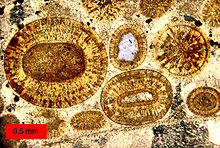Thin section: Difference between revisions
caps, links, spelling ... |
No edit summary |
||
| Line 20: | Line 20: | ||
* [http://www.logitech.uk.com/geol.asp Thin section preparation techniques] |
* [http://www.logitech.uk.com/geol.asp Thin section preparation techniques] |
||
* [[Ceramography| Thin sections of ceramics]] |
* [[Ceramography| Thin sections of ceramics]] |
||
* [http://www.endeeper.com/products/software Example of software for thin section analysis] |
|||
[[Category:Petrology]] |
[[Category:Petrology]] |
||
Revision as of 14:01, 1 September 2011




In optical mineralogy and petrography, a thin section is a laboratory preparation of a rock, mineral, soil, pottery, bones, even metal sample for use with a polarizing petrographic microscope, electron microscope and electron microprobe. A thin sliver of rock is cut from the sample with a diamond saw and ground optically flat. It is then mounted on a glass slide and then ground smooth using progressively finer abrasive grit until the sample is only 30 μm thick. The method involved using the Michel-Lévy interference colour chart. Typically quartz is used as the gauge to determine thickness as it is one of the most abundant minerals.
When placed between two polarizing filters set at right angles to each other, the optical properties of the minerals in the thin section alter the colour and intensity of the light as seen by the viewer. As different minerals have different optical properties, most rock forming minerals can be easily identified. Plagioclase for example can be seen in the photo on the right as a clear mineral with multiple parallel twinning planes. The large blue-green minerals are clinopyroxene with some exsolution of orthopyroxene.
Thin sections are prepared in order to investigate the optical properties of the minerals in the rock. This work is a part of petrology and helps to reveal the origin and evolution of the parent rock.
Ultra-thin sections
Fine-grained rocks, particularly those containing minerals of high birefringence, such as calcite, are sometimes prepared as ultra-thin sections. An ordinary 30 μm thin section is prepared as described above but the slice of rock is attached to the glass slide using a soluble cement such as canada balsam (soluble in ethanol) to allow both sides to be worked on. The section is then polished on both sides using a fine diamond paste until it has a thickness in the range of 2-12 μm. This technique has been used to study the microstructure of fine-grained carbonates such as the Lochseitenkalk mylonite in which the matrix grains are less than 5 μm in size.[1] This method is also sometimes used in the preparation of mineral and rock specimens for transmission electron microscopy and allows greater accuracy in comparing features using both optical and electron imaging.[2]
References
- Shelley, D. Optical Mineralogy, Second Edition. University of Canterbury, New Zealand.
